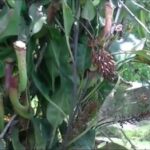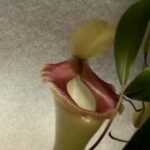As an Amazon Associate, this site earns commissions from qualifying purchases. For more details, click here.
With its distinctly shaped green-purple pitchers, nepenthes lowii is going to stand out among other plants anywhere. Native to Borneo, n. lowii is easy to grow and adapts well to indoors and outdoors. The key is making sure the environment is conducive to growth and development.
This highland pitcher plant prefers high humidity and 65-80 F temperature. Nepenthes lowii grows in partial sunlight or fluorescent lighting indoors. Water regularly so the soil is always moist and protect the plant from frost.
Soil
Nepenthes lowii requires low nutrient soil with good drainage. The potting media must be moist but not too wet. A good soil mix is 3 parts LFS (long fiber sphagnum), one part orchid bark or one part pumice.
The media must contain a high amount of coarse drainage material. At least 50% or its equivalent is ideal. If perlite is not available you can try peat, calcined clay, vermiculite or pine bark.
There are a lot of soil mix options available it can be confusing for a beginner. In general, nepenthes thrives in low mineral soil with good drainage. You can buy a custom made soil mix or prepare one yourself.
No matter what soil you choose, always keep it moist. Do not make it too wet, but just damp. You must also avoid using compost or any materials that might enrich the soil. Pitcher plants eat insects for nutrients so it is not need in the soil.
Pot Container
A 3-5 inch pot is the typical size used with nepenthes lowii. You can also use hanging baskets or grow it I terrarium.
Many pitcher plants including nepenthes sanguinea are often shipped in 3-4 inch pots. A small pot will do for a while because n. lowii grows slowly. But as the roots mature, it will need more space.
A 3 inch pot is sufficient for young nepenthes lowii, but a larger one might be better for older plants. It depends on how quickly your plant grows.
If the plant looks like it is getting too large for its container, repot it. Get a larger pot and prepare a new soil mix. You can use the same materials but do not use the soil that is in the pot.
Whether you use a pot, hanging basket or put it in a terrarium, always keep the plant in a warm, humid place, with moist soil and access to insects or other sources of nutrition.
Water
Water to keep the soil moist but not too wet. Do not use the tray method because it could cause root rot, especially if the plant is young. You can mist nepenthes lowii regularly to maintain high humidity.
If this is your first time to grow nepenthes, here are a few things to keep in mind. These are applicable to n. lowii and other nepenthes species.
- Do not use water that contains salt or any chemicals. Pitcher plants prefer purified, distilled or RO water. You may also use rainwater.
- Water from the top. Sprinkle all over the plant, leaves and soil. Repeat as often as needed to maintain soil moisture.
- Do not overwater the soil and do not sit the plant in water (the tray method). Nepenthes lowii is vulnerable to root rot particularly when young.
- Some people like to pour a bit of water in the pitchers, others do not. It will not hurt your plant as long as you do not fill it. However, a healthy nepenthes should be able to make liquids for its pitchers without any assistance.
Light
To speed up growth, nepenthes lowii should be in partial light. You can also use artificial lights to grow the plant in a terrarium.
Most nepenthes such as n. albomarginata and others thrive in partial or indirect light. The same here with n. lowii so you should set up its environment to get the right amount of light.
Partial light means the light only shines directly on the plant for a few hours a day. You could for instance, position the pot so sunlight hits it directly in the morning. Then for the rest of the day it only receives partial light.
You can do the same if the plant is a terrarium. Position its light source – like a CFL for instance – so that it shines directly on the plant for just a few hours.
While nepenthes requires light to survive, too much of it leads to dryness or even burns up its leaves. On way to manage light is to check the temperature as it affects heat intensity.
Temperature
The temperature should be 65-80 F (18-27 C). This plant can handle colder weather at night as long as it does not drop below 50 degrees.
If your n. lowii is in a terrarium, controlling the temperature is possible. As much as possible never let it drop below 60 F in the daytime and no higher than 80 F. It is definitely easier to raise this plant in this temperature range.
If you want to grow the plant outdoors, the climate must be tropical or close to it. If it is too hot or too cold, you should cultivate nepenthes lowii indoors as it adapts well. Of course a thriving nepenthes will tolerate some temperature fluctuations quite well.
Humidity
Keep nepenthes lowii in high humidity around 75% or higher. If humidity is too low its pitchers will have trouble producing liquids needed to trap and digest prey.
Humidity is also important for the organisms that have symbiotic relationships with pitcher plants. These animals live inside the pitcher and any changes in the environment could make inhospitable to them.
It is easier to manage humidity if your nepenthes is indoors or a terrarium. You can still grow the plant outside if the climate is ideal. If your region has very hot summers and freezing winters, humidity will fluctuate a lot and affect nepenthes.
In these situations it is more practical to grow nepenthes inside. A terrarium can give you more control over environmental factors, but you have to set it up carefully and thoroughly.
Nutrition and Feeding
Nepenthes lowii eats small bugs and insects. They are drawn to its pitcher and often fall in its trap. Digestive enzymes in the trap dissolve the bug and allows the plant to absorb its nutrients.
These pitcher plants have to eat at least every two weeks. You can feed them weekly. Even so it might take a while for n. lowii to grow.
You might be able to speed up the process by giving it foliar fertilizer. Add 1/4 Maxsea into a gallon of water and drop a few into its pitcher. You only have to do this every two weeks. If done properly this could speed up growth.
Too much foliar fertilizer can be risky especially if you do not get the mixture right. An alternative is to fd the plant fish pellets or freeze dried mealworms. Again you only have to put a little bit of food into the pitcher and that’s should be enough.
Dormancy
One of the reasons why nepenthes makes good houseplants is they do not need dormancy. Nepenthes lowii cannot survive frosting so you have to keep it indoors during winter.
One of the challenges of growing some carnivorous plants like Venus flytraps is that it goes dormant, which needs special care. Nepenthes lowii does not so you do not have to do anything unique.
This plant needs to be in the same type of environment all year: warm temperature, high humidity, partial light and moist soil. Maintain this and n. lowii will grow and thrive.
The other advantage of these plants is you can propagate at any time. You can also prune and repot whenever you feel It is necessary. For many, the biggest benefit is you do not have to change watering during winter.

My fascination with carnivorous plants began many, many years ago with Venus Fly Traps. Now I am more than happy to impart what I know with other enthusiasts and those who are curious about meat eating plants.



